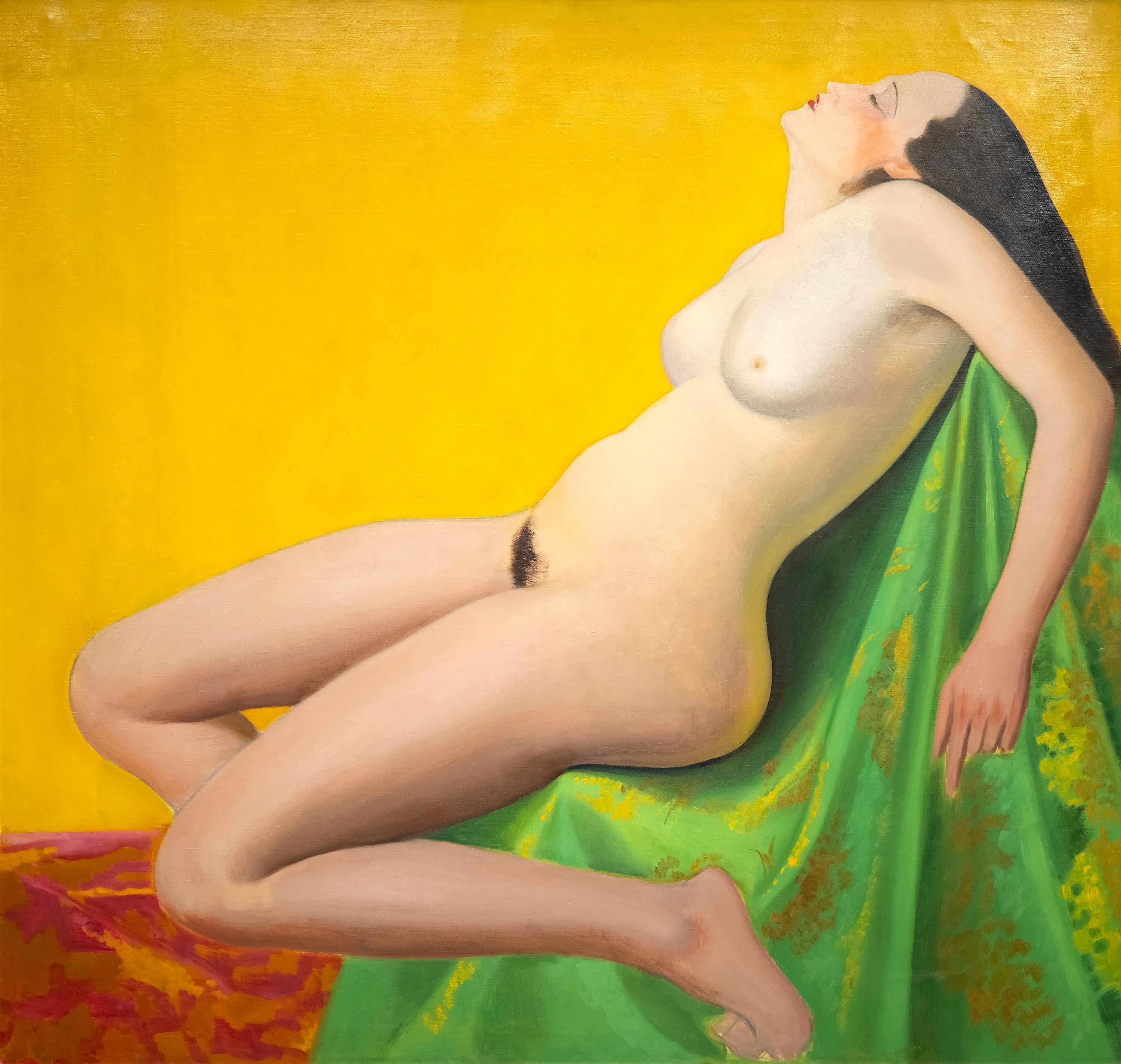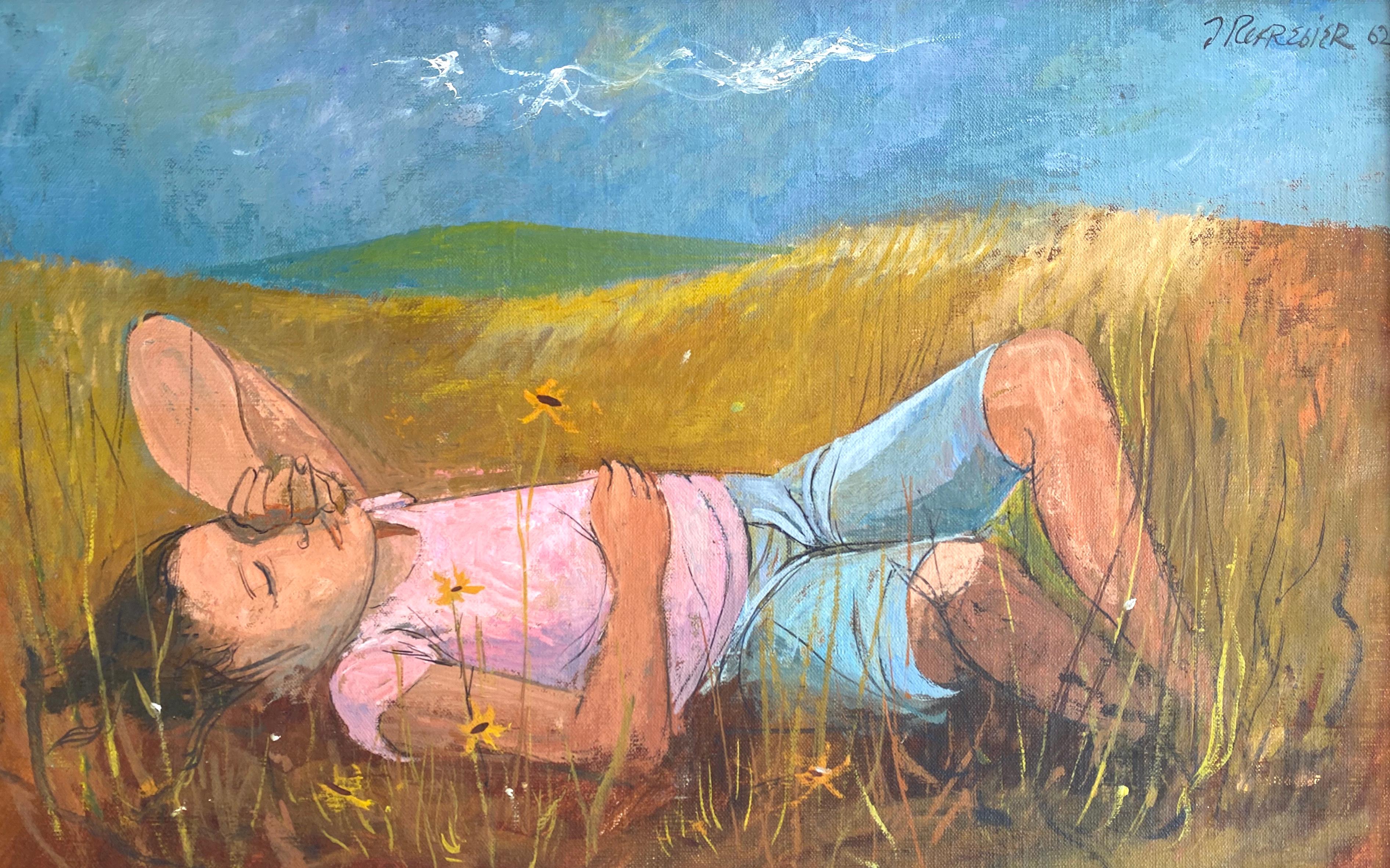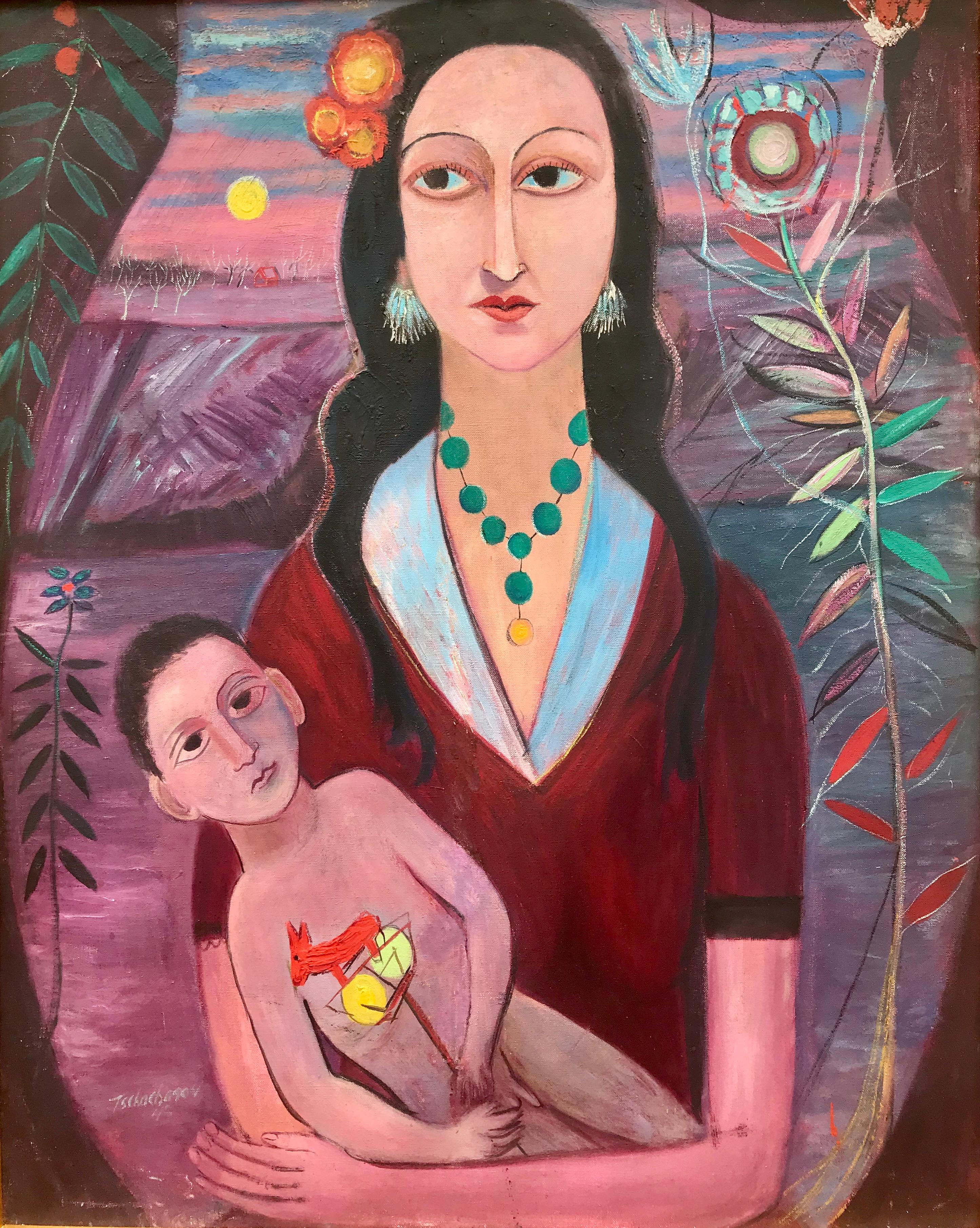Items Similar to "Girl with Guitar" Robert Gwathmey, Music, Southern Social Commentary, Modernism
Want more images or videos?
Request additional images or videos from the seller
1 of 14
Robert Gwathmey"Girl with Guitar" Robert Gwathmey, Music, Southern Social Commentary, Modernism1965
1965
About the Item
Robert Gwathmey
Girl with Guitar, 1965
Signed upper right
Oil on canvas
16 x 20 inches
Provenance:
The artist
ACA Galleries, New York
Mr. Moses Asch, New York
Terry Dintenfass Gallery, New York
Christie's East, November 14, 1991, Lot 440
Private Collection
Catherine Dail Fine Art, New York
Exhibited:
New York, Terry Dintenfass Gallery, Paintings and Silkscreen Prints, January 7 - 30, 1993.
New York, ACA Galleries, A Black Perspective, December 8, 2020 - May 1, 2021.
Richmond, Virginia Museum of Fine Arts, Storied Strings: The Guitar in American Art, October 8, 2022 - March 19, 2023, fig. 5.7, p. 102-4, illustrated; this exhibition traveled to Nashville, Tennessee, Frist Art Museum, May 26 - August 13, 2023.
Literature:
"Virginia Museum showcases guitar’s role in shaping America," Travel Courier, November 17, 2022, illustrated.
Steve Yarbrough, "The Sound of Wood and Steel," The American Scholar, May 25, 2023, illustrated.
W.A. Demers, "Storied Strings: The Guitar In American Art," Antiques and the Arts, November 8, 2022, illustrated.
Robert Gwathmey was a twentieth century artist who utilized his southern heritage as primary subject matter for his paintings. Although he lived most of his life in New York, he was born near Richmond, Virginia and traveled home frequently. An eighth-generation Virginian, Gwathmey was deeply impressed by his Southern heritage, something that is reflected by the imagery in his work.
Gwathmey's first formal artistic studies occurred in his twenties when he moved to Baltimore and enrolled at the Maryland Institute. "When I went to Baltimore to study art, the first thing I saw was Negro policemen and statues of Yankee generals. It was my first trip north, the farthest North I'd ever been, and I was 22 years old. When I got back home, I was shocked by the poverty. The most shocking thing was the Negroes, the oppressed segment. If I had never gone back home, perhaps, I would never have painted the Negro. I was shocked at the red clay, at the redness of the clay. The green pine trees and red clay were everywhere. The Negro seemed to be everywhere, too, omnipresent. But he was a thing apart, so segregated. When people ask me why I paint the Negro, I ask 'Don't artists have eyes'?"
Gwathmey advanced to studies at the Pennsylvania Academy of the Fine Arts where he won a Cresson scholarship that enabled him to travel to Europe during the summers of 1929 and 1930. There he saw the work of many artists covering a wide range of history; but apparently, he gravitated to the Gothic style above others.
Following his studies there, he taught at several schools in Pennsylvania before settling permanently in New York. Although New York became Gwathmey's favorite city in which to live and paint, he continued his established tradition of returning home to the South to visit family every year. In 1942, Gwathmey joined the faculty of the Cooper Union in New York, where he taught for 26 years.
In 1944-45, he received a Rosenwald Fellowship to live and work on a tobacco farm in North Carolina. Such an experience entrenched his work with rural southern themes and provided him with first-hand experiences to transfer to the canvas. The farmers particularly fascinated Gwathmey, their lean bodies with deliberate and stiff actions and often portrayed them as Christ-like figures.
Although the 1950s surge of Abstract Expressionism was definitely the reigning aesthetic of the time, Gwathmey took a stand against this movement, protesting against its rejection of representational art. He remained dedicated to the figural tradition, still relying on his subject matter to distinguish much of his art.
While Gwathmey was often labeled a "Social Realist," his imagery focusing on the lives of the African-American minority moves beyond pure social commentary on the plight of their situation within American society. Gwathmey remained true to his subject matter, but his exploration manifests a unique visual language. His work demonstrates a modernist tendency to abstract shapes, forms, and colors, all the while never abandoning the human figure. He incorporated such elements as large bands of color, low horizon lines, fragmentation of the human body, and completely flat picture planes into his paintings.
Gwathmey's distinctive style successfully fuses the formal elements of modern expression with a deeper, older tradition of realism. Despite the strength of Gwathmey's social and political commitments, perhaps his most effective work is less about advocacy for social change than an examination of the nature of community and the relationships between the races and sexes within his region.
Gwathmey's painting does not invoke social commentary per se, asking more for contemplation than pure action about the scene. Gwathmey's figures mimic the stained glass windows of the Gothic cathedrals he had seen almost two decades earlier with bright colors, bold patterning, and outlines in black. Pattern moves throughout his picture plane, typical of Gwathmey's ability to unite the figures into a tightly controlled, yet rhythmical composition.
Gwathmey himself stated, "I believe that in painting the use of limited imagery is the best method of presentation of your content. I believe that if the symbols are strong enough and simple enough and inventive enough, they can transcend literary [sic., literature?] in painting. One technical way of gaining this end is with simplified pattern. I'd also like to say that this is a modern way of painting…"
- Creator:Robert Gwathmey (1903 - 1988, American)
- Creation Year:1965
- Dimensions:Height: 17 in (43.18 cm)Width: 21 in (53.34 cm)
- Medium:
- Movement & Style:
- Period:
- Condition:
- Gallery Location:New York, NY
- Reference Number:1stDibs: LU1841213501302
Robert Gwathmey
Robert Gwathmey became an artist known for his Social Realist depictions of life in the rural South. He was one of the first white artists to create dignified images of African-American people and did so in a style that was Modernist with many geometric forms and bold coloration. Although he lived intermittently in Pennsylvania and in the South, he spent most of his 45-year career in New York City, where his studio was at 1 West 68th Street. Frequently, he returned to the South, where he became concerned about the problems dividing blacks and whites.
About the Seller
5.0
Platinum Seller
These expertly vetted sellers are 1stDibs' most experienced sellers and are rated highest by our customers.
Established in 2021
1stDibs seller since 2022
63 sales on 1stDibs
Typical response time: <1 hour
- ShippingRetrieving quote...Ships From: New York, NY
- Return PolicyA return for this item may be initiated within 3 days of delivery.
More From This SellerView All
- "Nude by the Mirror" Mid-Century Modern Expressionist and Cubist FigureBy Byron BrowneLocated in New York, NYByron Browne (1907 - 1961) Nude by a Mirror, 1958 Oil on canvas 26 x 20 inches Signed lower right Provenance: Doyle New York, Doyle + Design, June 7, 2017, Lot 20 Born in Yonkers,...Category
1950s American Modern Interior Paintings
MaterialsOil, Canvas
- "In Foreign Parts" Eugene Higgins, Southwestern Pueblo, Modern FigurativeBy Eugene HigginsLocated in New York, NYEugene Higgins In Foreign Parts, circa 1913 Signed lower right Watercolor on paper Sight 17 x 13 inches Born William Victor Higgins in 1884 to a Shelbyville, Indiana farm family where the only art Victor was aware of as a child was his father's love of flowers. "He loved their forms and their colors, and he tended his garden as a painter might work a canvas." At the age of nine, Victor met a young artist who traveled the Indiana countryside painting advertisements on the sides of barns. He purchased paints and brushes so the young Higgins could practice his own artwork on the inside of his father's barn. He also taught Victor about art museums and especially about the new Chicago Art Institute. This information never left the young artist, and he saved his allowance until his father allowed him at the age of fifteen to attend Chicago Art Institute. He worked a variety of jobs to finance his studies both there and at the Academy of Fine Arts. Victor Higgins traveled to New York in 1908, where he met Robert Henri, who became a significant influence by depicting every-day scenes and stressing the importance of the spirit and sense of place as important factors in painting. Higgins was also greatly affected by the New York Armory Modernism Show of Marsden Hartley in 1913. While Victor Higgins was in Chicago he met former mayor and avid collector Carter H. Harrison who was to prove instrumental in the growth of Higgins career for several years. Harrison agreed to support Higgins for four years to go to Paris and Munich and paint and study in the great museums in Europe. While at the Academie de la Grande Chaumier in Paris (1910-1914) he met Walter Ufer, who was another Chicago artist being sponsored by Carter Harrison. This meeting was not only a life-long friendship, but the beginning of a great change in the way Higgins looked at "American" art. He decided that America needed it's own authentic style rather than the 19th Century classic style he was taught in Europe. Very soon after returning to Chicago in 1914, Harrison sent him and Walter Ufer on a painting trip to Taos, New Mexico for a year in exchange for paintings. Higgins made other similar agreements and was able to support himself with his painting. This trip was a life-changing experience and introduced Higgins to the authentic America he had been looking for. In 1914 Taos was an isolated village about twelve hours from Santa Fe on an impossible dirt road. But the colorful life of the pueblo people and the natural beauty drew a collection of artists who became the Taos art colony, from which the Taos Society of Artists was founded in 1915. Victor Higgins became a permanent resident within a year of his arrival and a member of the society in 1917, exhibiting with Jane Peterson in 1925 and with Wayman Adams and Janet Scudder in 1927. The members would travel around the country introducing the Southwest scenes with great success. He remained a member until the Society's dissolution in 1927. Higgins was the youngest member of the group of seven. Other members were Joseph Henry Sharp, Bert Phillips...Category
1910s American Modern Figurative Drawings and Watercolors
MaterialsWatercolor, Paper
- "Winter in the Valley" Aldro T. Hibbard, Winter Countryside, ImpressionismLocated in New York, NYAldro T. Hibbard Winter in the Valley Signed lower right Oil on canvas 24 x 30 inches Born in Falmouth, Massachusetts, Aldro Hibbard was an Impressionist landscape painter much con...Category
Mid-20th Century Modern Figurative Paintings
MaterialsCanvas, Oil
- "Pueblo Indians, Taos, New Mexico, " Georgia Klitgaard, Southwest LandscapeBy Georgina KlitgaardLocated in New York, NYGeorgina Klitgaard Pueblo Indians, Taos, New Mexico Signed lower right Oil on canvas 18 x 24 inches Georgina Berrian was born in Spuyten Duyvil, New York in 1893. She was educated a...Category
Mid-20th Century Modern Landscape Paintings
MaterialsCanvas, Oil
- "Portrait of a Woman with Red Hat, Paris, " Isabella HowlandLocated in New York, NYIsabella Howland Portrait of a Woman, Paris, 1925 Oil on canvas laid on board 19 1/2 x 16 1/2 inches Provenance: Hammer Galleries, New York Private C...Category
1920s Modern Figurative Paintings
MaterialsCanvas, Oil, Board
- "A Toast" Realist, Figures in Interior, Early American 19th Century Oil PaintingLocated in New York, NYLouis Charles Moeller A Toast Signed lower right Oil on canvas 12 x 16 inchesCategory
19th Century Realist Figurative Paintings
MaterialsCanvas, Oil
You May Also Like
- Reclining NudeBy Joseph StellaLocated in Palm Desert, CAA painting by Joseph Stella. "Reclining Nude" is a figurative painting, oil on canvas in a bright palette of yellows, greens, and tans by American Modernist artist Joseph Stella. The...Category
Early 20th Century American Modern Figurative Paintings
MaterialsCanvas, Oil
- Abstract painting of People on the Beach oil on canvas circa 1950-1960 New YorkBy Aaron BerkmanLocated in Rancho Santa Fe, CAAaron Berkman (New York, 1900 - 1929) "Beach" Oil on canvas 20 x 24 inches Signed lower right: Aaron Berkman Unframed Provenance: Private collection, USA An abstract oil painting o...Category
Mid-20th Century American Modern Figurative Paintings
MaterialsCanvas, Oil
- Girl in a White Dress, Oil Painting on Canvas by Edith Varian CockcroftBy Edith Varian CockcroftLocated in Long Island City, NYArtist: Edith Varian Cockroft, American (1881 - 1962) Title: Girl in a White Dress Year: 1961-1962 Medium: Oil on Canvas, signed l.r.(signed Cocroft) ...Category
1960s American Modern Figurative Paintings
MaterialsCanvas, Oil
- “Girl in the Grass”By Anton RefregierLocated in Southampton, NYOriginal oil on canvas painting by Anton Refregier of a young girl resting in the grass. Signed upper right and dated 1962. Condition is very good. The painting is in its original oa...Category
1960s American Modern Figurative Paintings
MaterialsCanvas, Oil
- William Fisher Classic American Illustration on CanvasLocated in Larchmont, NYWilliam Fisher (American, 1891-1985) Untitled, 20th Century Oil on canvas/illustration 23 3/4 x 29 3/4 in. Framed: 31 x 37 1/4 x 1 in. Signed lower right: William Fisher William Fis...Category
20th Century American Modern Figurative Paintings
MaterialsCanvas, Oil
- “The Green Necklace”By Nahum TschacbasovLocated in Southampton, NYOil on canvas original painting by The Russian/ American artist, Nahum Tschacbasov. Signed lower left and dated 1943. Condition is very good. Framed in custom contemporary gold le...Category
1940s American Modern Figurative Paintings
MaterialsCanvas, Oil
Recently Viewed
View AllMore Ways To Browse
Music Vintage Art
Vintage Southern Art
Old Robert
Robert Wood Painting
Robert Summers
American School Southern Painting
Robert March
Robert August
Oil Painting Modernism
Music Themed Oil Painting
Robert Wood Oil
Robert Wood Oil Painting
Robert Sayer
Early European Modernism
Guitar Sign
Signed Guitar
Girls In Windows
Guitar Paintings




